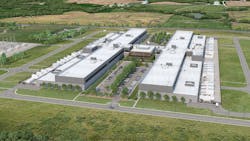Meta Platforms Nets Long-Term Clean Energy Credits Deal for Indiana Solar Farm
Arevon Energy and Meta Platforms have signed a long-term environmental attributes purchase agreement for the former’s 60 MW Heirloom solar project in Pike County, Indiana.
The project has begun construction and is predicted to be fully operational in the third quarter of 2025. Arevon will own and operate the project.
Earlier this year, Meta announced it was building a data center in Jeffersonville, Indiana. The tech giant also signed a PPA with Solarpack in the state.
Meta, parent company of Facebook, is acquiring the carbon emissions reduction credits as part of the deal, which is different from a typical power purchase agreement (PPA). Under PPAs, the buyer may not receive the renewable energy directly, but its investment pays for development and deployment of the project.
The Meta-Arevon environmental attributes agreement and solar energy production also creates royalty income for local landowners for the life of the project. Many utility-scale solar farms have an operational life expectancy of 20 to 25 years, according to reports.
Arevon's activities in Pike County will disburse more than $86 million to local governments over their lifespans, the company says. The projects will create about 200 full-time equivalent jobs to build the facilities. The construction activity and the projects' eventual operations will strengthen the local economy with expenditures at local businesses.
Arevon and Meta also announced two long-term environmental attributes purchase agreements in March 2024 for the Kelso solar project in Scott County, Missouri. The project will deliver 349 MW of power to support Meta's regional operations with 100% renewable energy.
Meta has invested deeply in renewable solar and wind PPAs in Ireland, Tennessee, Arizona, Texas and Missouri, among others. The developers working with the tech giant to build the utility-scale projects include Silicon Ranch, EDP, Avangrid, RWE and Arevon, among others.
Meta says its net zero activities have reduced emissions to 273 net metric tonnes, although some journalistic investigation indicates the tech giant’s emissions are still much higher.
Many energy experts believe that the rise of artificial intelligence and cloud-based computing capacity is creating an electricity crisis to fuel future data centers. Goldman Sachs has forecast that some 47 GW of new data center capacity may be built in the U.S. through the rest of this decade, creating the need for a dramatic expansion in microgrids, renewable energy and even small modular nuclear plants.
The Intersection of Data Centers and Energy in Focus
at Data Center Frontier Trends Summit Sept. 4-6 in Reston, Virginia
About the Author
Rod Walton, EnergyTech Managing Editor
Managing Editor
For EnergyTech editorial inquiries, please contact Managing Editor Rod Walton at [email protected].
Rod Walton has spent 17 years covering the energy industry as a newspaper and trade journalist. He formerly was energy writer and business editor at the Tulsa World. Later, he spent six years covering the electricity power sector for Pennwell and Clarion Events. He joined Endeavor and EnergyTech in November 2021.
Walton earned his Bachelors degree in journalism from the University of Oklahoma. His career stops include the Moore American, Bartlesville Examiner-Enterprise, Wagoner Tribune and Tulsa World.
EnergyTech is focused on the mission critical and large-scale energy users and their sustainability and resiliency goals. These include the commercial and industrial sectors, as well as the military, universities, data centers and microgrids. The C&I sectors together account for close to 30 percent of greenhouse gas emissions in the U.S.
He was named Managing Editor for Microgrid Knowledge and EnergyTech starting July 1, 2023
Many large-scale energy users such as Fortune 500 companies, and mission-critical users such as military bases, universities, healthcare facilities, public safety and data centers, shifting their energy priorities to reach net-zero carbon goals within the coming decades. These include plans for renewable energy power purchase agreements, but also on-site resiliency projects such as microgrids, combined heat and power, rooftop solar, energy storage, digitalization and building efficiency upgrades.

